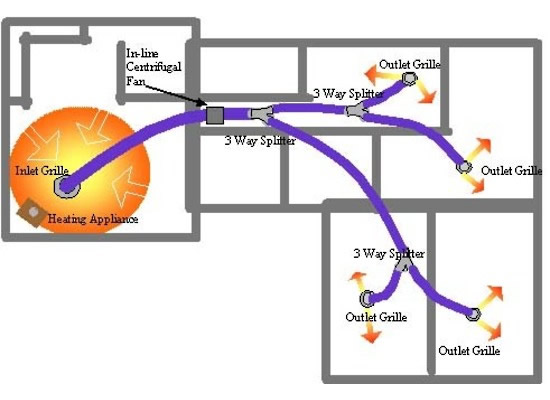Real-Time Monitoring: How DVS Heat Transfer Systems Enable Predictive Maintenance
Wiki Article
The Function of Heat Transfer Systems in Sustainable Energy Solutions for the Future
Heat transfer systems are important in the pursuit for sustainable energy options. They maximize thermal power monitoring, enhancing the efficiency of renewable technologies. By employing mechanisms like conduction, radiation, and convection, these systems minimize energy losses. Their duty in solar thermal and geothermal applications is particularly substantial. As innovations emerge, the potential for more advancements elevates vital inquiries concerning future power methods. What advancements will shape the landscape of sustainable power?Recognizing Heat Transfer Solutions

The Relevance of Thermal Power Management
Efficient thermal power management is essential for maximizing power efficiency and reducing waste in numerous systems. By controling temperature level and enhancing Heat transfer processes, companies can significantly reduce power usage and operational expenses. Efficient administration includes the implementation of advanced technologies and techniques that monitor and regulate thermal problems within systems, ensuring that energy resources are used efficiently. Additionally, correct thermal energy monitoring adds to lowering greenhouse gas discharges, lining up with global sustainability objectives. It likewise enhances system dependability and performance, resulting in improved item high quality and longer equipment life-span. Ultimately, focusing on thermal power administration is a crucial step in the direction of creating a lot more sustainable energy services and promoting a responsible method to power usage in property and industrial contexts.Applications of Heat Transfer in Renewable Power
While numerous renewable resource sources promise sustainability, the reliable application of Heat transfer plays a vital role in their performance. In wind energy systems, Heat transfer is utilized for generator part cooling, boosting performance and longevity. Geothermal energy depends on reliable Heat exchange between the earth's subsurface and the fluid distributing in the system, optimizing power extraction. Biomass energy processes also take advantage of Heat transfer, as it aids in converting natural materials into functional gas with pyrolysis and gasification. In addition, in hydropower, keeping optimal temperatures in reservoirs can improve power output. Each of these applications shows the critical significance of Heat transfer systems in enhancing renewable resource modern technologies, eventually contributing to a much more sustainable energy future.Enhancing Solar Thermal Power Performance
As solar thermal power systems continue to progress, improving their performance has actually become crucial for making the most of energy output. Breakthroughs in Heat transfer innovations, such as improved thermal storage materials and cutting-edge Heat exchangers, play a substantial role in boosting efficiency. By making use of advanced products that have remarkable thermal conductivity, systems can transfer and capture Heat better. Furthermore, integrating radar that comply with the sun's course guarantees that collection agencies obtain ideal solar direct exposure throughout the day. Using nanotechnology in solar absorbers can further boost power absorption prices. Including computerized control systems aids regulate temperature levels and take care of energy distribution successfully, leading to minimized losses and boosted general system performance. These improvements lead the method for even more lasting solar thermal energy solutions in the future.Geothermal Home Heating: A Lasting Remedy
Geothermal home heating offers a sensible choice for lasting power, supplying considerable environmental advantages through reduced greenhouse gas discharges. Its efficiency and cost-effectiveness make it an attractive option to traditional home heating systems. Difficulties associated to execution has to be dealt with to maximize its prospective impact.Environmental Benefits of Geothermal
Although traditional heating methods contribute significantly to greenhouse gas exhausts, geothermal heating presents an engaging alternative that lessens ecological effect. By utilizing the Earth's interior Heat, geothermal systems utilize a renewable resource source, significantly lowering dependence on fossil gas. This approach produces minimal carbon exhausts, making it a cleaner choice for household and business home heating. Additionally, geothermal systems promote power efficiency, as they require much less power compared to traditional heater. DVS Heat Transfer Systems. The use of geothermal power additionally aids in minimizing air pollution, improving regional air top quality and public health and wellness. As a sustainable service, geothermal home heating supports environment adjustment reduction initiatives, positioning itself as an important element in the change in the direction of a greener futurePerformance and Cost-Effectiveness
Just how does geothermal heating measure up in terms of performance and cost-effectiveness compared to standard heating unit? Geothermal home heating shows premium effectiveness, commonly achieving a coefficient of performance (POLICE OFFICER) of 3 to 5, meaning it produces 3 to 5 devices of Heat for every device of power consumed. This efficiency equates into reduced operating prices, particularly in areas with secure geothermal resources. Initial installation expenses can be more than standard systems; however, lasting cost savings on power bills and decreased maintenance costs can counter these ahead of time financial investments. Additionally, numerous federal governments incentivize geothermal systems via refunds and tax credit reports, improving their cost-effectiveness. Overall, geothermal home heating arises as a sustainable and economically sensible option to more traditional home heating options.Implementation Difficulties and Solutions
Various difficulties can impede the prevalent implementation of geothermal heating systems, in spite of their clear benefits as a lasting power option. High initial installation prices often discourage property owners and capitalists, making funding a significant obstacle. Furthermore, the geographical restrictions of ideal geothermal sites restrict availability in certain regions. Regional laws and permitting procedures can also make complex job growth, bring about delays. Furthermore, public awareness and understanding of geothermal systems continue to be reduced, preventing acceptance. To deal with these difficulties, targeted education and learning projects can enhance open secret, while government rewards can alleviate financial concerns. Collaborating with neighborhood authorities to improve laws may facilitate smoother job approvals, ultimately advertising the fostering of geothermal heating as a sensible, sustainable power choice.Developments in Heat Transfer Technologies
Technologies in Heat transfer modern technologies play a vital role in boosting energy performance and sustainability. Advanced Heat exchangers and phase adjustment materials are at the center of these developments, providing considerable improvements in thermal monitoring. These innovations not just enhance energy use yet also contribute to lowering environmental impact in different applications.Advanced Heat Exchangers
Advanced Heat exchangers play a vital role in enhancing energy effectiveness throughout various applications in lasting power options. These devices promote the transfer of Heat between two or even more fluids, significantly minimizing energy consumption in procedures such as commercial heating, air conditioning, and power generation. Innovations in materials and layout, such as using nanofluids and compact configurations, have actually led to enhanced thermal efficiency and reduced dimension requirements. In addition, developments in digital monitoring and control systems permit for enhanced operation, further raising efficiency. By decreasing waste Heat and making the most of power healing, progressed Heat exchangers contribute to lower carbon impacts and support the shift towards eco pleasant technologies. Their continued growth is important for achieving international power sustainability objectives.
Stage Modification Products
The combination of phase modification products (PCMs) into Heat transfer modern technologies stands for a substantial improvement in energy administration and performance. PCMs soak up and release thermal power throughout their phase adjustments, enabling reliable temperature level guideline in structure materials and power systems. By saving excess Heat during peak periods and launching it when need increases, PCMs contribute to fill moving and power preservation - DVS Heat Transfer Systems. This ability improves the efficiency of renewable resource systems, specifically in solar thermal applications. Additionally, PCMs can enhance the thermal convenience of indoor atmospheres, minimizing reliance on traditional heating and cooling down methods. As innovations in PCM formulas proceed to emerge, DVS Heat Transfer Systems their duty in lasting power solutions is positioned to grow, providing encouraging methods for future study and application
Future Prospects for Heat Transfer in Sustainable Energy
As the need for sustainable power options remains to climb, the function of Heat transfer systems is becoming progressively important fit future technologies. Advancements in layouts and materials are expected to enhance efficiency in Heat transfer, lowering power losses in various applications. The assimilation of advanced thermal storage space systems, such as phase adjustment materials and thermochemical storage space, will make it possible for far better administration of energy sources. Research study into nanofluids and biomimetic Heat exchangers may further maximize thermal efficiency. The fostering of smart modern technologies will allow for real-time tracking and adaptive control of Heat transfer processes. These developments are poised to greatly add to the overall performance and sustainability of energy systems, leading the way for an extra energy-efficient future.Frequently Asked Inquiries
How Can People Implement Heat Transfer Equipment in your home?

People can execute Heat transfer systems at home by setting up energy-efficient appliances, using radiant heating, and maximizing insulation. These measures improve power efficiency, minimize prices, and promote lasting techniques in domestic settings.

What Are the Prices Connected With Setting Up Heat Transfer Equipments?
The expenses connected with installing Heat transfer systems vary widely, usually including equipment, installation labor, and upkeep. Aspects such as system type, home dimension, and regional policies substantially affect the overall expense included.Are There Federal Government Rewards for Heat Transfer System Installations?
Federal government rewards for Heat transfer system setups vary by region and can consist of tax credit ratings, gives, and rebates. These financial benefits intend to encourage fostering, inevitably promoting energy effectiveness and decreasing environmental impact within communities.Exactly How Do Heat Transfer Systems Impact Power Expenses?
Heat transfer systems notably influence power bills by enhancing power efficiency. By improving the transfer of Heat, these systems lower energy consumption, causing reduced utility costs and producing a much more lasting approach to energy administration.What Upkeep Is Needed for Heat Transfer Equipments?
Upkeep for Heat transfer systems includes regular assessments, cleansing of parts, examining liquid degrees, ensuring proper insulation, and replacing worn parts. These tasks assist preserve effectiveness, stop failures, and lengthen the system's functional life-span.These systems facilitate the movement of thermal energy from one medium to another, enabling the transfer of Heat for air conditioning, home heating, or energy generation objectives. Geothermal power depends on efficient Heat exchange between the planet's subsurface and the liquid flowing in the system, taking full advantage of energy extraction. In addition, geothermal systems advertise power effectiveness, as they need less energy contrasted to standard home heating systems. Advanced Heat exchangers play a crucial function in improving energy performance throughout different applications in sustainable power remedies. Heat transfer systems notably influence energy bills by maximizing energy performance.
Report this wiki page